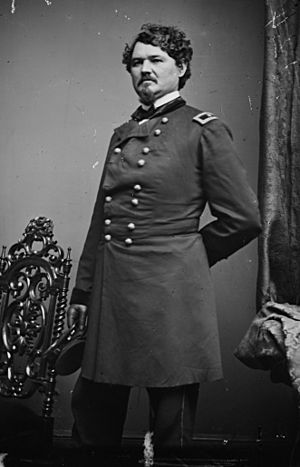Samuel D. Sturgis facts for kids
Quick facts for kids
Samuel D. Sturgis
|
|
|---|---|

Sturgis in uniform, c. 1862
|
|
| Birth name | Samuel Davis Sturgis |
| Born | June 11, 1822 Shippensburg, Pennsylvania, U.S. |
| Died | September 28, 1889 (aged 67) Saint Paul, Minnesota, U.S. |
| Buried | |
| Allegiance | |
| Service/ |
United States Army |
| Years of service | 1846–1886 |
| Rank | |
| Commands held | 6th U.S. Cavalry 7th U.S. Cavalry |
| Battles/wars | Mexican War (POW) Civil War |
| Spouse(s) |
Jerusha Wilcox
(m. 1851) |
| Relations | Samuel D. Sturgis Jr. (son) Samuel D. Sturgis III (grandson) |
| Signature | |
Samuel Davis Sturgis (born June 11, 1822 – died September 28, 1889) was an important officer in the United States Army. He fought in three major conflicts: the Mexican War, the Civil War, and the Indian Wars. He reached the rank of major general, which is a very high position in the army.
Contents
Early Life and Military Start
Samuel D. Sturgis was born in Shippensburg, Pennsylvania. When he was twenty years old, he joined the United States Military Academy, also known as West Point. He graduated in 1846. His class was famous because it included many future generals. Some of them, like George B. McClellan and George Stoneman, fought for the Union. Others, like Thomas "Stonewall" Jackson and George Pickett, fought for the Confederacy.
Serving in the Mexican War
During the Mexican War, Sturgis served with the 1st Dragoons. He was captured by the enemy for eight days while exploring near Buena Vista, Mexico. After the war, he worked in the western United States. He was promoted to first lieutenant and then captain. He also took part in several campaigns against Native American tribes.
Family Life
While serving in the West, Sturgis met Jerusha Wilcox in West Ely, Missouri. They got married in 1851 and had six children together.
Sturgis in the Civil War
When the Civil War began, Sturgis continued to serve with the 1st Dragoons. This unit was soon renamed the 1st Cavalry Regiment. In May 1861, he was promoted to major. Later, he moved to the 4th Cavalry Regiment.
Leading Troops in Battle
In August 1861, at the Battle of Wilson's Creek, Sturgis took command of the Union forces. This happened after Brigadier General Nathaniel Lyon was killed in battle. In March 1862, Sturgis became a brigadier general of volunteers. This rank was given to him because of his bravery at Wilson's Creek.
After some time in Washington, D.C., Sturgis was sent to help General John Pope's army. This was just before the Second Battle of Bull Run. Sturgis was known for his strong opinions.
Key Battles and Challenges
Sturgis commanded the 2nd Division in the IX Corps. He led his troops in important battles like South Mountain, Antietam, and Fredericksburg.
In 1863, he moved west with the IX Corps. He was promoted to lieutenant colonel with the 6th U.S. Cavalry. He had several smaller commands in Tennessee and Mississippi. During the winter of 1863–1864, he led the Cavalry Corps of the Department of the Ohio near Dandridge, Tennessee.
In June 1864, Sturgis faced a major defeat. He was routed by Confederate General Nathan Bedford Forrest at the Battle of Brice's Crossroads in Mississippi. This battle largely marked the end of his active service in the Civil War.
After the Civil War Ends
In March 1865, Sturgis was honored with the rank of brigadier general for his actions at South Mountain. He also became a major general for his service at Fredericksburg. In August, he left the volunteer service. He returned to his regular army rank of lieutenant colonel in the 6th U.S. Cavalry.
Commanding the 7th Cavalry
On May 6, 1869, Sturgis became a colonel and commander of the 7th U.S. Cavalry. His second-in-command was George Armstrong Custer.
Sturgis was away from his regiment when parts of the 7th Cavalry were destroyed at the Battle of Little Big Horn. Sadly, one of Sturgis's sons, Second Lieutenant James G. Sturgis, was an officer with the 7th Cavalry and was killed in that battle.
Samuel Sturgis then took personal command of the regiment. He led the 7th Cavalry in the campaign against the Nez Percé people in 1877. Sturgis and his soldiers tried to stop the Nez Percé as they came out of Yellowstone Park. However, the Nez Percé tricked Sturgis and escaped, continuing their journey north toward Canada. Sturgis soon caught up with them. But at the Battle of Canyon Creek, even though the Nez Percé were outnumbered, they managed to escape from him again.
Later Years and Legacy
From 1881 to 1886, Sturgis was the governor of the Soldiers' Home in Washington, D.C.. He retired in 1886 and passed away in Saint Paul, Minnesota in 1889. He is buried with his wife, Jerusha, at Arlington National Cemetery in Arlington, Virginia.
His son, Samuel D. Sturgis Jr., also became a general in the United States Army. He commanded a division during World War I. His grandson, Samuel D. Sturgis III, also became a general and served as the Chief of Engineers from 1953 to 1956.
Honoring Samuel Sturgis
The city of Sturgis, South Dakota, is named after Samuel D. Sturgis. There is a sculpture of him riding a horse at the eastern entrance of the town.
The USS General S. D. Sturgis (AP-137), a ship used to transport troops during World War II, was also named in his honor.
See also
- List of American Civil War generals (Union)

